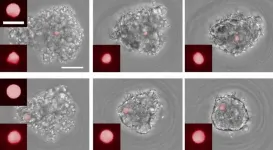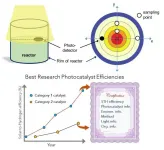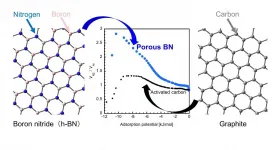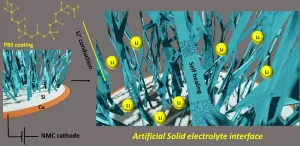(Press-News.org) PROVIDENCE, R.I. [Brown University] -- A new technique developed by Brown University researchers reveals the forces involved at the cellular level during biological tissue formation and growth processes. The technique could be useful in better understanding how these processes work, and in studying how they may respond to environmental toxins or drug therapies.
As described in the journal Biomaterials, the technique makes use of cell-sized spheres made from a highly compliant polymer material, which can be placed in laboratory cultures of tissue-forming cells. As the tissue-formation process unfolds, microscope imaging of the spheres, which are stained with fluorescent dye, reveals the extent to which they are deformed by the pressure of surrounding cells. A computational algorithm then uses that deformation to calculate the forces at work in that cellular microenvironment.
"We know that mechanical forces are important stimuli in tissue formation and development, but actually measuring those forces is pretty difficult," said Eric Darling, an associate professor of medical science, engineering and orthopedics at Brown. "These spheres that we've developed give us an extremely sensitive technique for measuring those forces over time in the same sample. And we can do this with multiple samples at a time on a 96-well plate, so it's a high-throughput method as well."
The research was a collaboration between Darling's lab and the lab of Haneesh Kesari, an assistant professor of engineering at Brown and an expert in solid mechanics. Darling and graduate student Robert Gutierrez developed the spheres and performed cell culture experiments with them, while Kesari and graduate student Wenqiang Fang developed the computational algorithm to calculate the forces.
The spheres are made from a polymer called polyacrylamide. The spheres have no apparent effect on the behavior of the newly forming tissues, Darling said, and the polyacrylamide material has mechanical properties that are highly consistent and tunable, which made it possible to make spheres soft enough to deform measurably when exposed to cellular forces.
"The key to this is having a highly controlled material, with a very precise shape as well as finely tuned and uniform mechanical stiffness," Kesari said. "If we know the properties of the spheres, then we can take pictures of how their shapes change and back out the forces necessary to make those changes."
As a proof of concept, the researchers performed a series of experiments to measure forces involved in mesenchymal condensation -- a process in which stem cells cluster together and eventually differentiate into tissue-specific cell types. The process is central to the formation of teeth, bones, cartilage and other tissue.
In one experiment, the team included the force-sensing spheres in cultures of cells were coming together to form multicellular balls. Microscope images of the cultures were taken every hour for 14 hours, enabling the team to track changes in the forces involved in each culture over time. The experiments showed that the forces involved in mesenchymal condensation were highly variable for the first 5 or so hours of the process, before settling down into a much steadier force profile. This was the first time such force dynamics had ever been measured, the researchers say.
To help verify that the spheres were truly sensitive to cellular forces, the team repeated the experiment using cultures treated with a cytoskeletal inhibitor, a drug that weakens the tiny contractile motors inside a cell. As expected, the spheres detected markedly weaker forces in the cultures treated with the drug.
In another set of experiments, the researchers added the sensor spheres to preformed cellular masses to observe how the spheres were taken up into the mass. Some of the spheres had been treated with a collagen coating, which enables cells to bind with the sensors, while others were uncoated.
"We were able to see differences in the force profiles between the coated and uncoated spheres," Darling said. "Overall there was a large compressive force, but with the coated cells we could see the cells interacting with the spheres directly, pulling on them and exerting a tensile force as well."
Darling says he's hopeful the technique could reveal fundamental details about how tissue-forming processes work. In the future, it may also be used screen drugs aimed at modulating these processes, or to test the effects of environmental toxins. It could also be useful in tissue engineering.
"If we want to grow cartilage, it might be helpful to know that the types of forces that these cells are exerting on each other because we might be able to apply an external force that matches or complements that force profile," Darling said. "So in addition to fundamental discovery, I think there is some translational potential for this down the road."
INFORMATION:
The work was funded by the National Institutes of Health (R01 AR063642), National Science Foundation (2018260690) and a Brown University Research Seed Award.
Bird species that live in their natural habitats can help zoos learn how to manage those in captivity, according to a new review.
Birds are the most diverse group housed by zoos around the world, but zoo-based research tends not to focus on birds.
A new article published in the journal Birds, by Dr Paul Rose of the University of Exeter, suggests zoos can improve management of birds by looking at how species live in their natural habitats.
Likewise, birds living under the care of humans can also help guide and develop conservation action for those living in the wild.
"Research into wild birds is extremely useful for furthering how birds are managed in zoos," said ...
Scientists have made a significant breakthrough in the quest to understand the intricate processes that occur in the brain during seizures that are the key symptom of epilepsy.
A team of scientists from the University of Exeter has studied the mechanisms behind distinctive patterns of electrical activity of neuron groups in the brain that accompany the onset of seizures.
In healthy brains, networks of neurons move through states of similar behavior - known as synchronization - and dissimilar behavior, called desynchronization. These processes are also associated with both memory and attention.
However, in a brain with a neurological disorder, such as epilepsy, ...
Neuroscientists at McMaster University have found a link between children who are at risk for developmental coordination disorder (DCD), a common condition that can cause clumsiness, and difficulties with time perception such as interpreting changes in rhythmic beats.
Accurate time perception is crucial for basic skills such as walking and processing speech and music.
"Many developmental disorders, including dyslexia or reading difficulties, autism and attention deficits have been linked to deficits in auditory time perception," says Laurel Trainor, senior author of the study and founding director of the McMaster Institute for Music and the Mind.
Previous research has shown the brain ...
(Boston)--A new study recommends healthy children with symptoms of sleep disordered breathing, such as snoring or temporary cessation of breathing, should consider undergoing a sleep study (polysomnography) and should discuss the potential benefits of this with their pediatrician or otolaryngologist to possibly manage the child's symptoms medically and before surgery.
Sleep disordered breathing is common in children and ranges from mild snoring to severe sleep apnea. Doing a sleep study provides more information on the severity of the condition. Often doctors suggest adenotonsillectomy ...
Utilization of renewable solar energy is crucial for addressing the global energy and environmental concerns and achieving sustainable development in our society. In this regard, photocatalytic water splitting has attracted significant interest as a cost-effective means to convert sustainable solar energy into valuable chemicals.
However, efficiency is sensitive to reaction conditions and experimental setup, it is difficult to compare the results obtained by different research groups or provide a reliable guide for large-scale implementation. Due to the ...
What is common between a technology for storing energy in a solar cell and that for water purification? They both rely on the use of porous materials, or more specifically, "nanoporous" materials that can trap gas molecules within narrow spaces on their surface, called "pores", which are only nanometers (one-billionth of a meter) in size! In chemistry parlance, the phenomenon is known as "adsorption" and has played an important role in the synthesis of porous materials of different compositions, pore sizes, and even pore geometries.
Traditionally, activated carbon (AC, or a porous form of carbon) has been a popular adsorbent for practical applications owing to its higher capacity of adsorption than that of other porous materials. Lately, however, porous boron ...
Treating severe COVID-19 patients with the anticancer drug bevacizumab may reduce mortality and speed up recovery, according to a small clinical study in Italy and China that was led by researchers at Karolinska Institutet in Sweden between February and April 2020. On average, blood oxygen levels, body temperature and inflammatory markers significantly improved in patients treated with a single dose of bevacizumab in addition to standard care. The research is published in Nature Communications.
"To reduce COVID-19 mortality, we aim to develop an effective therapeutic paradigm for treating patients with severe COVID-19," says corresponding author Yihai ...
A research team led by Prof. HE Shunping from the Institute of Hydrobiology (IHB) of the Chinese Academy of Sciences has discovered through genome sequencing that the non-teleost ray-finned fishes--bichir, paddlefish, bowfin and alligator gar--exhibit mosaic genomic features of lobe- and ray-finned fishes. The study was published in Cell.
The water-to-land transition during the Devonian is one of the most prominent events in vertebrate evolution. During this transition, various organs underwent adaptive changes, particularly those related to locomotion and respiration systems.
Rich fossil evidence suggests that many traits and functions related to this terrestrial evolution were present long before the ancestor of lobe- and ray-finned fishes ...
Although silicon anodes could greatly boost the capacity of Li-ion batteries, their performance rapidly degrades with use. Polymeric coatings can help solve this problem, but very few studies have explored the underlying mechanisms. In a recent study, scientists from Japan Advanced Institute of Science and Technology investigate how a poly(borosiloxane) coating greatly stabilizes the capacity of silicon anodes, paving the way for better and more durable Li-ion batteries for electric cars and renewable energy harvesting.
Since their conception, lithium-ion batteries (LIBs) have been constantly improved and adapted so that they can become suitable for vastly different applications, from mobile devices ...
Researchers from the Department of Infection and Immunity of the Luxembourg Institute of Health (LIH) brought forward the potential of high doses of a specific adjuvant molecule, namely CpG oligonucleotide, in successfully modulating the immune system's allergic response to the main cat allergen Fel d 1, thereby inducing a tolerance-promoting reaction and reverting the main hallmarks of cat allergy. The researchers analysed the molecular mechanisms underlying this tolerance and proposed a pre-clinical allergen-specific immunotherapy approach to improve the treatment and control of this common type of allergy. The full study results ...






